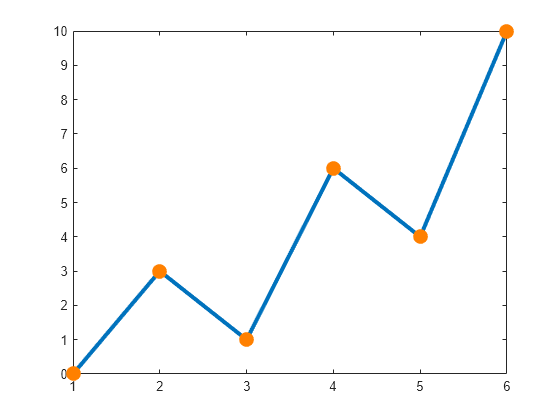指定绘图中的线和标记的外观
MATLAB® 使用一组默认线型、颜色和标记创建绘图。您使用这些默认值创建的不同绘图将呈现清晰一致的外观。您也可以按需求对绘图的这些方面进行自定义。许多绘图函数都有用于自定义的名为 linespec 的输入参量。此外,这些函数返回的对象通常具有控制绘图的这些方面的属性。参量和属性的名称可以不同,但它们接受的值通常遵循一种通用模式。一旦熟悉了该模式,您就可以使用它来修改各种绘图。
以下示例使用 plot 函数来演示自定义线条外观的整体方法。有关特定绘图函数选项的完整列表,请参考该函数的文档。
线型
默认情况下,大多数线图显示实线,但您可以使用下表中的任何线型来自定义该线。例如,用虚线创建一个线图:
plot([0 1 2 3],'--')| 线型 | 描述 | 表示的线条 |
|---|---|---|
"-" | 实线 |
|
"--" | 虚线 |
|
":" | 点线 |
|
"-." | 点划线 |
|
标记:
通常,除了线型之外,还可以指定标记符号。标记出现在图中的数据点上。例如,使用虚线和圆形标记创建一个线图:
plot([0 1 2 3],'--o')| 标记 | 描述 | 生成的标记 |
|---|---|---|
"o" | 圆圈 |
|
"+" | 加号 |
|
"*" | 星号 |
|
"." | 点 |
|
"x" | 叉号 |
|
"_" | 水平线条 |
|
"|" | 垂直线条 |
|
"square" | 方形 |
|
"diamond" | 菱形 |
|
"^" | 上三角 |
|
"v" | 下三角 |
|
">" | 右三角 |
|
"<" | 左三角 |
|
"pentagram" | 五角形 |
|
"hexagram" | 六角形 |
|
指定颜色、线型和标记的组合
许多绘图函数都有一个用于指定颜色、线型和标记的参量。例如,plot 函数有可选的 linespec 参量,用于指定其中的一个或多个方面。(您也可以在创建绘图后通过设置属性来修改绘图。)
通过将 linespec 参量指定为 '--or',创建一个具有红色虚线和圆形标记的图。对于这种组合,'--' 对应于虚线,'o' 对应于圆形标记,'r' 对应于红色。
plot([1 2 3 4 5 6],[0 3 1 6 4 10],'--or')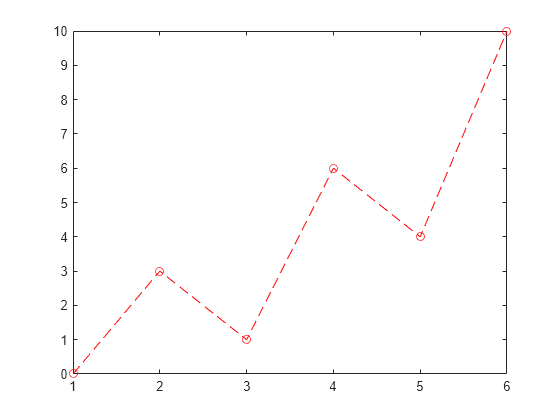
您不需要指定线条的所有三个方面。例如,如果仅指定标记,则绘图会以默认颜色显示标记,且不显示线条。
plot([1 2 3 4 5 6],[0 3 1 6 4 10],'o')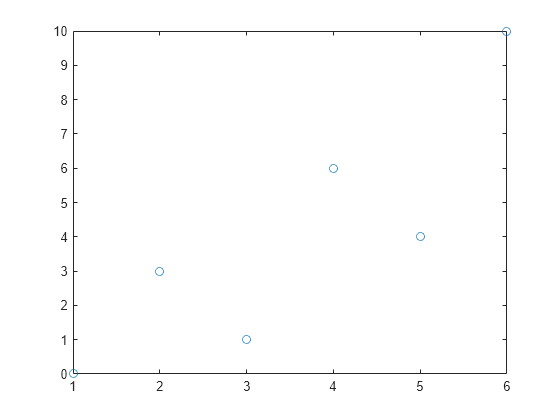
您可以使用 linespec 参量来指定命名颜色,但要指定自定义颜色,请设置对象属性。例如,Line 对象具有 Color 属性。
用具有圆形标记的紫色线创建一个图。在 linespec 参量中仅指定线条和标记符号。将 Color 属性单独设置为名称-值参量。将 Line 对象作为 p 返回,以便您以后更改其他属性。
p = plot([1 2 3 4 5 6],[0 3 1 6 4 10],'-o','Color',[0.5 0 0.8]);

接下来,通过将 Color 属性设置为十六进制颜色代码 '#00841a',将线条的颜色更改为绿色。然后将线型更改为虚线,并将标记更改为星号。
在 R2019a 之前,将颜色指定为 RGB 三元组,而不是十六进制颜色代码。例如,p.Color = [0 0.52 0.10]。
p.Color = '#00841a'; p.LineStyle = '--'; p.Marker = '*';
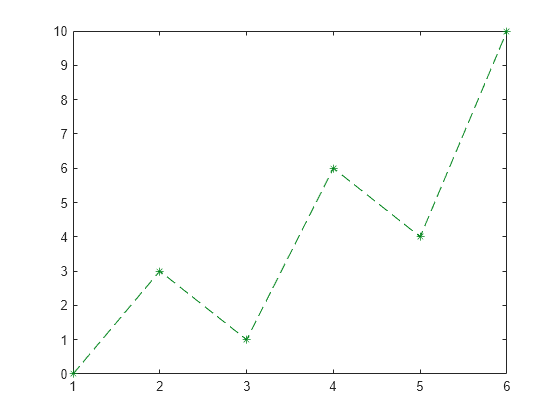
修改线宽、标记填充和标记轮廓
您可以通过设置属性来修改线的其他方面。例如,Line 对象具有用于控制线条粗细的 LineWidth 属性。要创建更粗的线条,可以在调用 plot 函数时将 LineWidth 指定为名称-值参量。在本例中,请将 LineWidth 设置为 3。将 Line 对象作为 p 返回,以便您以后设置其他属性。
p = plot([1 2 3 4 5 6],[0 3 1 6 4 10],'-o','LineWidth',3);
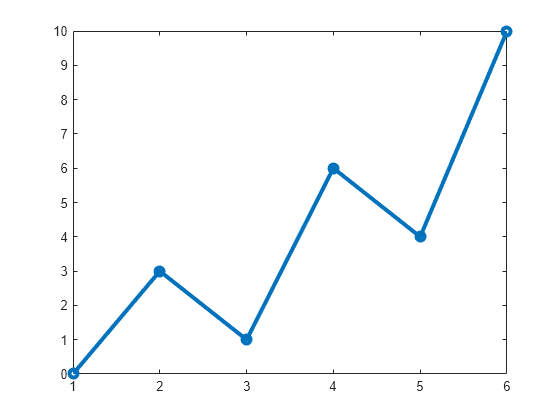
通过设置 Line 对象的 MarkerFaceColor 属性,用橙色填充标记。然后通过设置 MarkerSize 属性将标记大小增大到 8。
p.MarkerFaceColor = [1 0.5 0]; p.MarkerSize = 8;

通过设置 MarkerEdgeColor 属性,更改标记的轮廓以匹配填充颜色。
p.MarkerEdgeColor = [1 0.5 0];
